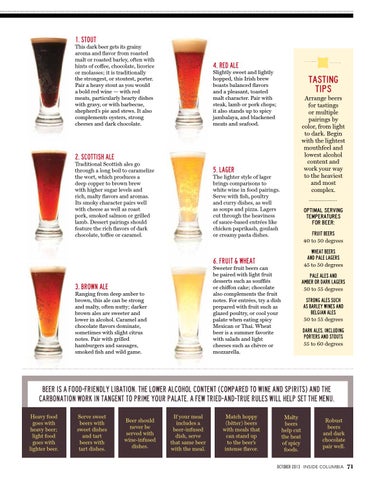1. Stout
This dark beer gets its grainy aroma and flavor from roasted malt or roasted barley, often with hints of coffee, chocolate, licorice or molasses; it is traditionally the strongest, or stoutest, porter. Pair a heavy stout as you would a bold red wine — with red meats, particularly hearty dishes with gravy, or with barbecue, shepherd’s pie and stews. It also complements oysters, strong cheeses and dark chocolate.
4. red ale
Slightly sweet and lightly hopped, this Irish brew boasts balanced flavors and a pleasant, toasted malt character. Pair with steak, lamb or pork chops; it also stands up to spicy jambalaya, and blackened meats and seafood.
Tasting Tips Arrange beers for tastings or multiple pairings by color, from light to dark. Begin with the lightest mouthfeel and lowest alcohol content and work your way to the heaviest and most complex.
2. Scottish ale
Traditional Scottish ales go through a long boil to caramelize the wort, which produces a deep copper to brown brew with higher sugar levels and rich, malty flavors and aromas. Its smoky character pairs well with cheese as well as roast pork, smoked salmon or grilled lamb. Dessert pairings should feature the rich flavors of dark chocolate, toffee or caramel.
5. lager
The lighter style of lager brings comparisons to white wine in food pairings. Serve with fish, poultry and curry dishes, as well as soups and pizza. Lagers cut through the heaviness of sauce-based entrées like chicken paprikash, goulash or creamy pasta dishes.
Optimal serving temperatures for beer: Fruit beers 40 to 50 degrees wheat beers and pale lagers 45 to 50 degrees
6. fruit & wheat
Sweeter fruit beers can be paired with light fruit desserts such as soufflés or chiffon cake; chocolate also complements the fruit notes. For entrées, try a dish prepared with fruit such as glazed poultry, or cool your palate when eating spicy Mexican or Thai. Wheat beer is a summer favorite with salads and light cheeses such as chèvre or mozzarella.
3. brown ale
Ranging from deep amber to brown, this ale can be strong and malty, often nutty; darker brown ales are sweeter and lower in alcohol. Caramel and chocolate flavors dominate, sometimes with slight citrus notes. Pair with grilled hamburgers and sausages, smoked fish and wild game.
pale ales and amber or dark lagers 50 to 55 degrees strong ales such as barley wines and belgian ales 50 to 55 degrees dark ales, including porters and stouts 55 to 60 degrees
Beer is a food-friendly libation. The lower alcohol content (compared to wine and spirits) and the carbonation work in tangent to prime your palate. A few tried-and-true rules will help set the menu. Heavy food goes with heavy beer; light food goes with lighter beer.
Serve sweet beers with sweet dishes and tart beers with tart dishes.
Beer should never be served with wine-infused dishes.
If your meal includes a beer-infused dish, serve that same beer with the meal.
Match hoppy (bitter) beers with meals that can stand up to the beer’s intense flavor.
Malty beers help cut the heat of spicy foods.
Robust beers and dark chocolate pair well.
october 2013 inside columbia
71
